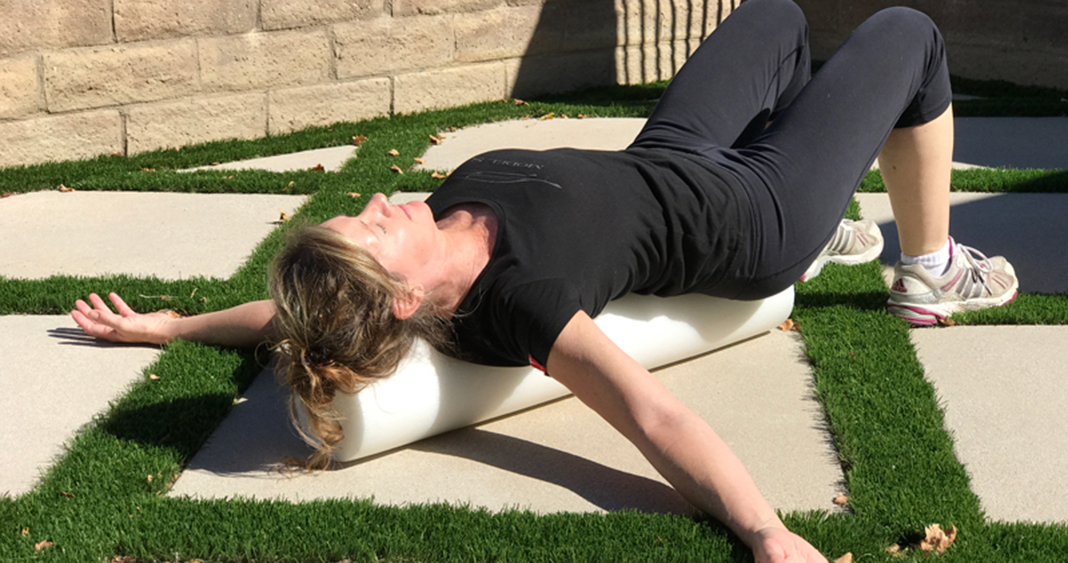Does stretching matter? Believe it or not, this is an age-old question in the world of medicine. The jury after all these years is still out! There are trainers, coaches, chiropractors, physical therapists and medical doctors that continue to agree to disagree on whether or not stretching is a benefit to the human body. I happen to be one that believes strongly in the benefits of stretching, especially as it relates to our comfort and ability to ride motorcycles.
First, let’s look at the physiological facts regarding muscle tissue. Think of your muscles as a telephone cable. (Remember when phones were hooked to the wall? Hopefully, you bear with me while I revisit the “old school” way.) Inside one very large cable are thousands of tiny cables or fibers that transport all of the information to the end point. In others words, your telephone rings and you converse with the person on the other end. With our bodies the other end of the line is the brain.
What if only 50 to 75 percent of your cable wires are long enough to reach the other end of the line? The telephone conversation will be mumbled, static or “CAN YOU HEAR ME NOW?” Well, our muscles function sort of the same way. If you are only using 50 to 75 percent of your muscle fibers, the message to the brain is mumbled, static or “CAN YOU EVEN HEAR ME NOW FOR GOODNESS SAKE?!”
So, what makes a muscle only partially function? Glad you asked! Several things can prevent muscle fibers from firing at full capacity: dehydration, injury, muscle disuse (couch potato disease), hard workouts (can’t win…damned if you do, damned if you don’t), surgery, swelling, muscle imbalance, chronic disease and, finally, muscle tightness, which can be a result of all the previous factors.
Take a moment to revisit the telephone cable. The cable is getting a mumbled message to you because only 50 to 75 percent of the cable is long enough to reach the other end with the signal. The other 25 percent of the cable fibers are too short, damaged or kinked and cannot carry the full message all the way to the end. It’s the same with your body.
In simple terms, stretching allows us to essentially untangle the remaining 25 percent of the cable/fibers to make them reach, allowing our brains to receive a clear signal and our muscles to function to full capacity. Actually, the process is a somewhat more complicated than this, but hopefully this gives you an idea. Stretching after being on your bike for hours and lengthening out those shortened or cramped (kinked) muscle fibers can make your body overall much happier. Also, it can help rejuvenate you and get you ready for that next long day on the road, track or trail.
That said, just like our “Six Exercises to Get You Fit for the Riding Season” article, you don’t have to ride a motorcycle for these to be beneficial!
A few things to keep in mind when stretching:
- You should experience a mild to moderate pulling sensation.
- Each stretch should be held for a minimum of 30 seconds.
- Never stretch to the point of feeling pain, only a mild to moderate pulling sensation.
I am going to start with what I think is the most important stretch, and it can help alleviate a lot of upper body issues: the Roll Stretch. To perform this, you’ll need a foam roll (like the ones you’ve likely seen at your gym or at the sporting goods store). On the road or otherwise don’t have a foam roll available? No problem! I’ve found some pretty ingenious hacks for when I’m on the road and traveling on my bike. Hotel pillows, a large bath towel rolled lengthwise, a sleeping bag or a rolled-up sleeping pad all work well. Go ahead and be creative, but remember the No. 1 rule: whatever you use, just make sure that you have your head and tailbone supported. In the picture below I used my sleeping bag and Therm-a-Rest sleeping pad, but those do not support my whole spine, so I used my motorcycle jacket and folded it to support my lower back.

The Roll Stretch
Lie down on your back on the roll. Make sure that your head and tailbone are well supported. The Roll Stretch consists of a series of four parts that are a combo of static (non-moving) and dynamic stretching (gentle movement).
1) Pec Stretch – Static hold of mild to moderate pulling sensation for no less than 30 seconds in duration.

2) Heel Reach – Dynamic stretching. Place arms with hands palms up along the side of the roll. Make sure you keep as much of your lower arm in contact with ground as possible. Alternately reach towards your heels in a gentle and slow motion. Try to keep a gentle rhythmic motion going for approximately one minute or count your reaches to 60 reps. You can always go longer if you wish.

3) Swim – Dynamic stretching. Place arms at your side and alternately reach overhead. As you get close to your head relax the elbow and just let gravity help you the rest of the way. Don’t force your motion! Just go as far as you can somewhat comfortably. Most people will notice one arm does not go as far as the other. Usually your dominant arm is a little tighter. Repeat this rhythmic motion for one minute or count to 60 reps.

4) Butterfly – Dynamic stretching. Place hands in the hollow area under your neck where there is not any contact with the roll. Gently interlace fingertips behind your neck, never pulling on your neck. Gently and rhythmically bring elbows up and down. Some of you will be able to touch your elbows together and some might not. Do not force the motion, again let gravity help you.


5) Pec Stretch – I know, I said four parts! But I like to end with another pec stretch because this will usually give you some instant feedback for the minutes you just spent giving back to your body. Normally you will feel that you can stretch a little further than you could the first time around.
Forearm Stretches
Many people end up with hand issues from riding. Numbness, tingling, elbow pain and diminished use of fingers are common complaints. Making these forearm stretches a regular part of your routine might help.
Extensor Stretch – Static stretch. With shoulder relaxed and elbow locked, bend your wrist, pointing fingers towards the ground. Gently use your other hand to put a little over pressure on the backside of your hand. Stretch until you feel a mild to moderate pulling sensation along the topside of your forearm and back of your wrist. Breathe, relax and hold for a minimum of 30 seconds.

Flexor Stretch – Static stretch. With shoulder relaxed and elbow locked, bend your wrist, pointing fingers towards the sky. Gently use your other hand to put a little over pressure on the palm side of your hand. Stretch until you feel a mild to moderate pulling sensation along the bottom side of your forearm and wrist. Breathe, relax and hold for a minimum of 30 seconds.

Lower Body Stretches
After sitting on your bike for hours, your body will love these lower body and back stretches!
Hamstrings – Static stretch. Here are two different ways you can perform this stretch; if you have a lot of lower back problems it is advisable to do option B.
A) In a standing position, place your heel on the ground with toes up, knee locked. Now bend forward from the hips, keeping your back flat. Gently lean forward until you can feel a mild to moderate pulling sensation behind your knee. Breathe, relax and hold for minimum of 30 seconds.
 B) Lie on your back. In this position your spine will be completely supported. Place a rope, leash, belt or yoga strap around your forefoot. Extend your leg so that it is straight. Lock your knee and gently pull your toes towards you until you feel a mild to moderate pull up the back of your thigh or knee. Breathe, relax and hold for a minimum of 30 seconds.
B) Lie on your back. In this position your spine will be completely supported. Place a rope, leash, belt or yoga strap around your forefoot. Extend your leg so that it is straight. Lock your knee and gently pull your toes towards you until you feel a mild to moderate pull up the back of your thigh or knee. Breathe, relax and hold for a minimum of 30 seconds.

Hip Flexors – Static stretch. Try to pick a soft place to kneel down. The leg you are stretching will be the one that is knee down on the ground. Gently lean forward with your back straight until you feel a slight pull at the front of your hip/groin area. Lean until you feel a mild to moderate pull. Breathe, relax and hold for a minimum of 30 seconds.

Gastrocnemius – Static stretch. There are two options for this stretch.
A) In a standing position, find anything you can put your toes up on. You can use a wall, tree, motorcycle tire, curb…you get the idea! Once you have your toes up, lock your knee, stand up tall and lean forward with your whole body (vs. just sticking your butt out). Lean forward until you feel a mild to moderate pulling sensation. Breathe, relax and hold for minimum of 30 seconds.

B) I included this option because a lot of people prefer to lean against something. Pick the option that works best for you. The leg you are stretching is the one behind you. Your rear foot should be pointed straight ahead and your knee locked. Lean forward against tree, wall or fence with a straight body, not just sticking your butt out. Breathe, relax and hold for a minimum of 30 seconds.

Apart from stretching, there are other things you can do to lessen cramping and discomfort on longer rides, and one of the most effective is to make your motorcycle ergonomically correct for your body. Making your bike fit you with a custom seat, freeway pegs, handlebar risers, etc. will help you keep those muscles in a better state to begin with. That doesn’t necessarily mean you don’t need to stretch anymore, of course! In today’s smartphone/computer-driven society, most of our daily tasks require us to reach in front of us with our heads forward or down. Texting, driving, computer/desk work, housework…even if your “desk job” means riding a bike everyday, you fall into this category. Stretching to help to keep those muscles at their optimal length so they will carry a clearer signal to the brain will never hurt!
Some days you are the baseball, some days you are the bat…be humble, be kind, and enjoy the journey of life!














